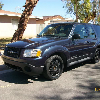I want a mid-size 4 door SUV to drive when my 2000 Sport is being modified. I was planning to purchase a 2000 4 door Explorer with the SOHC V6 to take advantage of what I've learned, spare parts and my SCT PCM programming software package. However, I realized that at my age my next project vehicle will probably be my last. I've always been partial to DOHC engines since I purchased a 1958 Jaguar XK-150 in 1965. A recent thread: '02 limited 4.0 to 4.6 dohc swap has captured my interest. I didn't know that the Aviator came with a DOHC V8 engine and was based on the 3rd generation Explorer. Since I don't like the looks of the Aviator front or the 500 lb weight disadvantage I've become very interested in swapping an Aviator engine into an Explorer. My long term objective would be a fairly quiet rear wheel drive 3rd Gen with a DOHC 4.6L V8 stroked to 5.0/5.1L and possibly forced induction.
I'm aware that the 2002 Explorer is probably the most complained about Explorer ever. Most of the complaints are associated with transmission failures. I could use some help researching which 3rd generation Explorer would be the best project vehicle.
I think the 5R55W and the 5R55S were possible transmissions. Were both used with the 4.6L? If so, is one more robust than the other?
Which transmission was installed in the Aviator with the DOHC 4.6L?
I've started another thread about the planned engine: DOHC 4.6L V8 build
I'm aware that the 2002 Explorer is probably the most complained about Explorer ever. Most of the complaints are associated with transmission failures. I could use some help researching which 3rd generation Explorer would be the best project vehicle.
I think the 5R55W and the 5R55S were possible transmissions. Were both used with the 4.6L? If so, is one more robust than the other?
Which transmission was installed in the Aviator with the DOHC 4.6L?
I've started another thread about the planned engine: DOHC 4.6L V8 build










